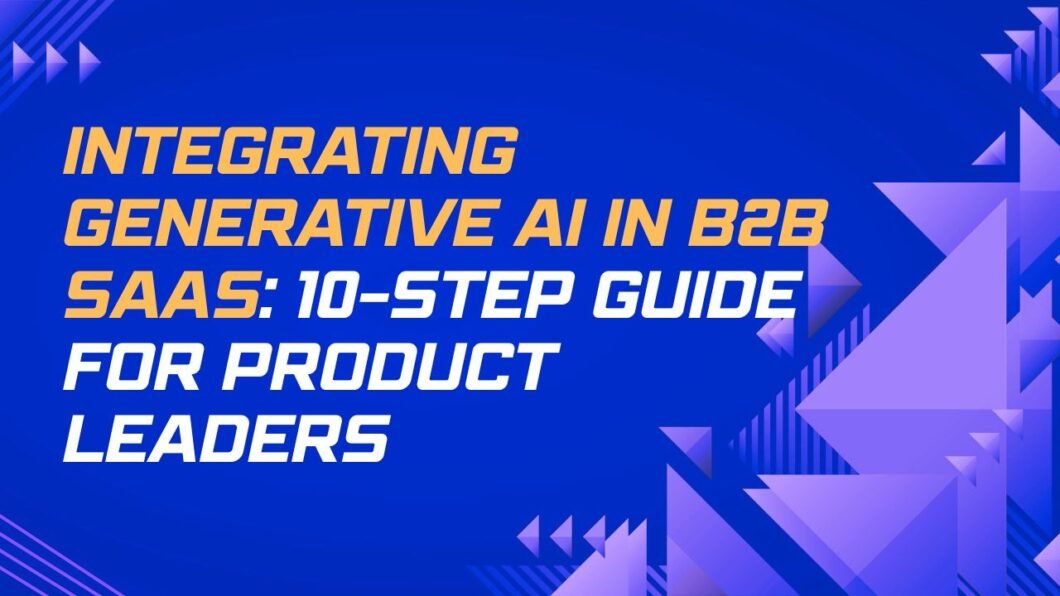The buzz around Generative AI in SaaS is deafening, and for good reason—it’s opening doors we only dreamed of a few years ago. Yet, amidst the excitement, there’s a crucial truth most product teams quietly acknowledge but rarely champion:
AI doesn’t magically fix a struggling product. What it does do, with remarkable precision, is amplify what’s already working well – and, perhaps uncomfortably, expose every creaky joint and underdeveloped corner.
Over the past year, I’ve been right there in the trenches, leading complex AI integrations across diverse landscapes: from the intricate world of enterprise CIAM platforms to the fast-paced demands of B2B productivity tools, and even the high-stakes environment of election software. These weren’t theoretical exercises. They were about building, testing, and iterating until AI truly delivered tangible value.
In this post, I’m pulling back the curtain to share a real-world, field-tested playbook. This isn’t just about the ‘what’ of AI; it’s about the ‘how’ – the journey from a vague idea to a feature that genuinely moves the needle for your users and your business.
🔍 Step 1: Hunt for Real Automation Opportunities (Beyond the ‘Cool’ Factor)
The most impactful GenAI features I’ve ever had a hand in didn’t kick off with a boardroom directive of, “Let’s add AI!” Honestly, that approach often leads to expensive gimmicks.
Instead, they began with a deep, almost empathetic dive into our users’ genuine pain points. We asked:
- What tasks are consuming an inordinate amount of our users’ valuable time?
- Where are the repetitive, soul-numbing manual processes that could be simplified or, better yet, eradicated?
- What makes our dedicated support teams sigh, “Oh no, not that again!” when a ticket comes in?
💡 Real-world example: Revolutionizing Election Setup at ElectionChamp
Imagine the complexity of setting up an election. Users historically wrestled with a labyrinth of manual configurations: crafting ballots with intricate rules, defining candidate lists, setting winner conditions, and navigating arcane selection constraints. It was a minefield of potential errors, costing countless hours and immense frustration.
My solution? A GenAI-powered prompt that felt like magic. Users simply typed:
“Create a ballot for Board Elections with 5 candidates (Candidate Names). Allow voters to select up to 3, and declare 2 winners.”
Behind the scenes, GenAI gracefully interpreted that natural language, returned a perfectly structured JSON configuration, and our application instantly built the ballot.
🧠 The transformative result: Election setup time plummeted. More profoundly, users no longer needed to become experts in complex election logic. They interacted with AI not as a rigid tool, but as an intuitive, highly intelligent teammate. This wasn’t just automation; it was empowerment.
🤖 Step 2: Thoughtfully Layer in Personalization with Agentic AI
Once you’ve nailed a truly useful automation, personalization is where you can truly 10x the value. But here’s the critical nuance: it must be inextricably linked to actual, measurable outcomes for your users. It’s not about adding more features; it’s about making existing features exponentially more effective.
Before we build, we ask ourselves:
- Does this personalization genuinely reduce user input or significantly lower their cognitive load?
- Does it proactively surface the precise ‘next best action’ they need to take, saving them from analysis paralysis?
- Does it feel like a genuine “power-up” that enhances their capabilities, rather than a distracting gimmick?
🔍 Example: Crafting Contextual Campaigns in Ampliyo
In a SaaS platform, Ampliyo, users leverage automated review requests, reminders, and marketing campaigns. We observed that while generic templates worked, they lacked resonance.
So, I introduced AI features that went far beyond mere content generation. These features created deeply personalized copy, dynamically adapting based on the specific business type (a bustling dental clinic versus a specialized physiotherapy center), the exact service offered, and the desired brand tone (warmly friendly versus crisply professional).
This wasn’t just “AI writing things.” This was goal-driven messaging, meticulously crafted with a keen understanding of context, all aimed at driving tangible outcomes like significantly higher review rates or increased repeat customer visits. It’s about impact, not just output.
💬 Step 3: Embrace Simplicity with Natural Language Prompts
Here’s a paradox: the biggest friction point in many GenAI features isn’t the underlying technology; it’s the interface, the interaction. If your users feel they need to “learn prompting” like a new programming language, they will, inevitably, disengage and give up.
Our mantra became: make it effortless. We constantly challenged ourselves with questions like:
- Can users simply say or type what they want, in their own words, without needing to conform to rigid syntax?
- Can the AI intelligently interpret intent and take the appropriate action, bridging the gap between human thought and machine execution?
- Can we offer thoughtful prompt templates or clear examples that guide users subtly, rather than demanding compliance?
💬 Example: The Game-Changing SAM Assist at S&P Global
At S&P Global, I delivered an internal chatbot, SAM Assist. Its power came not from its complexity, but from its simplicity and its meticulously curated knowledge base. We trained it on a vast ocean of internal data: comprehensive API documentation, detailed product guides, practical integration examples, and, crucially, a goldmine of FAQs sourced directly from our product, development, and support teams.
Now, instead of slogging through countless documents and wikis, our internal customer teams simply ask:
“How do I integrate license provisioning for external customers?”
And SAM Assist delivers an instant, precise reply, often complete with ready-to-use code samples in their preferred language.
👥 The profound result: Support volume plummeted, freeing up valuable human resources. Developer onboarding became largely self-serve, accelerating time-to-productivity. And perhaps most importantly, overall product integration velocity experienced a significant and measurable increase. This wasn’t just about answering questions; it was about empowering our entire ecosystem.
🔧 Step 4: Choose the Right Tools (Not Just the Flashiest)
Let’s dispel a common misconception: you absolutely don’t need a PhD in machine learning or your own custom-built LLM to harness the power of GenAI. The beauty of today’s landscape is the accessibility of powerful tools.
Start pragmatically. Here’s what I’ve found most effective:
- OpenAI (ChatGPT): Your workhorse for general-purpose tasks, initial content generation, and brainstorming. Its versatility is unmatched for broad applications.
- Claude or Gemini: Excellent choices for enterprise-friendly fine-tuning scenarios, offering robust performance and often better contextual understanding for longer inputs.
- Perplexity: An invaluable asset for rapid research, data synthesis, and quickly getting up to speed on unfamiliar topics or complex data sets.
- LangChain or Flowise: Essential for chaining together logic-based workflows, enabling you to build sophisticated, multi-step AI agents and applications.
- Vector Databases (e.g., Pinecone, ChromaDB): Your memory banks for AI, crucial for providing context, enabling retrieval-augmented generation (RAG), and ensuring your AI can “remember” past interactions or access specific knowledge.
🧠 Real Talk: The critical takeaway here isn’t about raw technological horsepower; it’s about fit. It’s about selecting the tool that precisely matches your problem, rather than forcing a problem to fit the flashiest tool.
🧪 Step 5: MVP Fast, Iterate Faster—The Startup Ethos for AI
Treat your GenAI feature with the same agile mindset you’d apply to any other Minimum Viable Product. The principles of rapid deployment and continuous learning are even more crucial in the fast-evolving AI landscape.
This means:
- Tight Scope: Define a very specific, high-value problem your AI feature will solve. Resist the urge to boil the ocean.
- Strong Hypothesis: Clearly articulate what you expect to happen, what success looks like, and what metrics you’ll track.
- Feedback Baked In: Design your feature from day one to capture user feedback, both explicit and implicit.
⛔ What not to do: Please, for the love of product integrity, do not build a GenAI feature just because it looks impressive in a demo. If users didn’t ask for it, if it doesn’t solve a tangible pain, it’s a vanity project, not a value driver.
🧠 Step 6: Prioritize UX Over Model Complexity—Always
This is a hill I’m willing to die on: An LLM with exceptional user experience will consistently outperform a brilliantly fine-tuned transformer that’s a pain to use. Your users don’t care about the intricacies of your model architecture; they care about how easy and effective it is to accomplish their goals.
Winning UX elements in the AI space include:
- Suggested Prompts: Proactively guide users by offering common or effective prompts. It’s like having a friendly co-pilot.
- Clickable Quick Actions: Allow users to refine or build upon AI-generated content with single clicks, reducing typing and cognitive load.
- AI-Generated Drafts with Human Edit Mode: Empower users with a strong starting point, but always provide an intuitive way for them to review, refine, and take full control. It’s a partnership, not a replacement.
- Confidence Scoring: Transparently communicate the AI’s certainty (e.g., “I’m 90% sure…” or “Here’s what I think you’re asking…”). This builds trust and sets realistic expectations.
📊 Step 7: Define What Success Really Looks Like—Beyond the Hype
Let’s be crystal clear: you’re not integrating GenAI into your product for a press release or to tick a box on a trend report. You’re doing it to solve genuine business challenges and deliver measurable value.
Before you write a single line of code, establish precise, quantifiable goals:
- Time Savings: Can you measure the average time saved per user session or for a specific task?
- Revenue Impact: Is it directly driving higher conversion rates, increased average deal size, or new revenue streams?
- Improved User Experience: Are you seeing a boost in user satisfaction scores (CSAT), a reduction in friction points, or an increase in key engagement metrics?
Track metrics that truly matter:
- Average time saved per user session for an AI-assisted workflow.
- A quantifiable drop in manual support tickets related to automated tasks.
- Increased adoption or self-serve setup rates for complex functionalities.
- A measurable retention lift for users who engage with AI-assisted flows.
If you can’t measure it, you can’t improve it. And if you can’t measure its impact, why are you building it?
🔁 Step 8: Feedback Loops Are Non-Negotiable—Your AI’s Lifeline
Think of feedback loops as the breathing system for your AI. A simple 👍 / 👎 after each AI interaction is a great start, providing quick sentiment. But to truly mature your AI, you need to go deeper. This is where the real learning happens.
Make it a habit to:
- Log Misunderstood Prompts: Systematically capture instances where the AI struggled to interpret user intent. This data is gold for prompt engineering and model refinement.
- Capture Fallback Triggers: Understand why and when your AI had to defer to a human. These are critical learning opportunities.
- Ask for Nuanced Feedback: Go beyond binary reactions. Ask users, “Was this helpful? If so, why? If not, why not?” Use open-ended questions to uncover insights you wouldn’t otherwise.
⚠️ Step 9: Guardrails and Governance Matter—Building Trust in B2B AI
Especially in the B2B SaaS realm, where data privacy, security, and reliability are paramount, you must be intentional about establishing robust guardrails and governance. This isn’t an afterthought; it’s foundational to building and maintaining user trust.
Proactively address:
- Data Privacy: Be scrupulous, especially if leveraging third-party APIs like OpenAI. Understand what data is being shared, how it’s used, and ensure strict compliance with all relevant regulations (GDPR, CCPA, etc.). Transparency with your users is non-negotiable.
- Rate Limits and Cost Control: API abuse is a very real threat. Implement robust monitoring and intelligent rate limiting to prevent runaway costs and ensure service stability.
- Hallucination Handling: This is critical. Never allow AI to confidently assert incorrect information. Design your system with mechanisms to detect low-confidence answers and either defer to human review, indicate uncertainty, or provide verified sources.
🧠 Step 10: AI Is a Multiplier, Not a Band-Aid—The Core Philosophy
This is perhaps the single most important lesson I’ve distilled from leading the development of multiple GenAI-powered products:
If your core product doesn’t genuinely solve a real problem for your users, adding AI won’t magically resuscitate it. It will, at best, add a layer of shiny complexity to an already struggling foundation.
However, if your product already delivers value – if it truly works, and you’ve identified tangible pain points that can be alleviated through intelligent automation or augmentation – then Generative AI can become an unparalleled force multiplier. It can elevate an already good product to an entirely new echelon of efficiency, personalization, and user delight.
Final Thoughts: Think Strategically, Start Practically
Don’t get caught in the paralysis of waiting for the “perfect” LLM or the next breakthrough. The time to act is now, but with intention.
Start with the user problem. Begin with empathy.
- Automate mundane workflows. ✅
- Personalize output with precision. ✅
- Ruthlessly reduce manual effort. ✅
- Make every interaction feel profoundly natural and intuitive. ✅
And always, always, with every feature, every iteration, every line of code, ask yourself this fundamental question:
“Is this making life unequivocally better for our users—or are we just adding more noise to an already loud world?”
The answer to that question will guide you to true AI impact.



